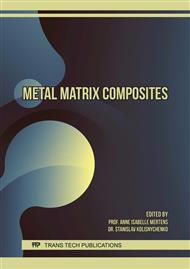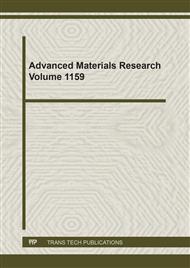[1]
Phillip J. Doorbar, Stephen Kyle-Henney, Development of Continuously-Reinforced Metal Matrix Composites for Aerospace Applications, Comprehensive Composite Materials II, Volume 4, 2018, pp.439-463.
DOI: 10.1016/b978-0-12-803581-8.09983-5
Google Scholar
[2]
I. Sharadadhadse, Pramila kumara, L J Bhagia, Fly ash characterization, utilization and government initiatives in India-A review, Journal of Scientific & industrial research, vol-67, 2008, pp.11-18.
Google Scholar
[3]
M. Ahmaruzzaman, A review on the utilization of fly ash, Progress in Energy and Combustion Science, 36, 2010, p.327–363.
DOI: 10.1016/j.pecs.2009.11.003
Google Scholar
[4]
G N Lokesh, M Ramachandra, KV Mahendra, T Sreenith, Effect of Hardness, Tensile and Wear Behavior of Al-4.5wt%Cu Alloy/Fly ash/SiC Metal Matrix Composites, International Journal of Modern Engineering Research, Vol.3, Issue.1, Jan-Feb. 2013, pp.381-385.
DOI: 10.4314/ijest.v5i4.7
Google Scholar
[5]
J. Sobczak, Z. Slawinski, N. Sobczak, P. Darlak, R. Asthana, P. K. Rohatgi, Thermal fatigue resistance of discontinuously reinforced cast aluminum-matrix composites, J. Mater. Eng. Perform. 11, 2002, p.595–602.
DOI: 10.1361/105994902770343566
Google Scholar
[6]
G.N. Lokesh, M.Ramachandra, K.V. Mahendra, Tensile and wear behaviour of Al-4.5%Cu alloy reinforced fly ash/SiC by stir and squeeze casting with rolled composites, International Journal on Mechanical Engineering and Robotics (IJMER), ISSN: 2321-5747, Volume-2, Issue-3, 2014, pp.10-15.
DOI: 10.4314/ijest.v5i4.7
Google Scholar
[7]
K. Tishmack, P.E. Burns, The chemistry and mineralogy of coal and coal combustion products, Geol. Soc. Special Pub.236, 2004, p.223–246.
DOI: 10.1144/gsl.sp.2004.236.01.14
Google Scholar
[8]
N. Sobczak, J. Sobczak, J. Morgiel, L. Stobierski, TEM characterization of the reaction products in aluminium–fly ash couples, Materials Chemistry and Physics 81, 2003, p.296–300.
DOI: 10.1016/s0254-0584(02)00606-5
Google Scholar
[9]
P. Shanmughasundaram, R. Subramanian, G. Prabhu, Some Studies on Aluminium – Fly Ash Composites Fabricated by Two Step Stir Casting Method, European Journal of Scientific Research, ISSN 1450-216X, Vol.63 No.2, 2011, pp.204-218.
DOI: 10.4028/www.scientific.net/amr.488-489.775
Google Scholar
[10]
A.Chavez-Valdez, A. Arizmendi-Morquecho, G. Vargas, J. M. Almanza, J. Alvarez-Quintana, Ultra-low thermal conductivity thermal barrier coatings from recycled fly-ash cenospheres, Acta Materialia, Volume 59, Issue 6, 2011, pp.2556-2562.
DOI: 10.1016/j.actamat.2011.01.011
Google Scholar
[11]
P.K. Rohatgi, D. Weiss, N. Gupta, Applications of fly ash in synthesizing low-cost MMCs for Automotive and Other Applications, Journal of Materials Processing Technology 58, 2006, p.71–76.
DOI: 10.1007/s11837-006-0232-4
Google Scholar
[12]
Shuangjian Li, Xiaoqin Zhao, Yulong An, Wen Deng, Ianmin Chen, Effect of deposition temperature on the mechanical, corrosive and tribological properties of mullite coatings, Ceramics International, Volume 44, Issue 6, 2018, pp.6719-6729.
DOI: 10.1016/j.ceramint.2018.01.087
Google Scholar
[13]
Mahendra.K.V and Radhakrishna.K , Fabrication of Al–4.5% Cu alloy with fly ash metal matrix composites and its characterization, Materials Science-Poland, Vol. 25, No. 1, 2007, pp.57-68.
Google Scholar
[14]
Sudarshan, Surappa M.K., Synthesis of fly ash particle reinforced A356 Alcomposites and their characterization, Materials Science and Engineering A 480, 2008, p.117–124.
DOI: 10.1016/j.msea.2007.06.068
Google Scholar
[15]
Dinaharan,R. Nelson, S. J. Vijay, E. T. Akinlabi, Microstructure and wear characterization of aluminum matrix composites reinforced with industrial waste fly ash particulates synthesized by friction stir processing Materials Characterization, Volume 118, 2016, pp.149-158.
DOI: 10.1016/j.matchar.2016.05.017
Google Scholar
[16]
Lateef N. Assi, Edward Eddie Deaver, Paul Ziehl, Effect of source and particle size distribution on the mechanical and microstructural properties of fly Ash-Based geo polymer concrete Construction and Building Materials, Volume 167, 2018, pp.372-380.
DOI: 10.1016/j.conbuildmat.2018.01.193
Google Scholar
[17]
Jin-Cheng Liu, Kang Hai Tan, Shengxin Fan, Residual mechanical properties and spalling resistance of strain-hardening cementitious composite with Class C fly ash, Construction and Building Materials, Volume 181, 2018, pp.253-265.
DOI: 10.1016/j.conbuildmat.2018.06.009
Google Scholar
[18]
Vikas Verma, P. C. Tewari, Roshan Zameer Ahamed, Syed Touseef Ahmed, Effect of Addition of Fly ash and Al2O3 Particles on Mechanical and Tribological Behavior of Al-MMC at Varying Load, Time and Speed, Procedia Structural Integrity 14, 2019, p.68–77.
DOI: 10.1016/j.prostr.2019.05.010
Google Scholar
[19]
G.N. Lokesh, S.Karunakara, Impact of Particle size distribution for variable mixing time on mechanical properties and microstructural evaluation of Al-Cu/B4C composite, Materials Today: Proceedings 22, 2020, p.1715–1722.
DOI: 10.1016/j.matpr.2020.02.190
Google Scholar
[20]
W.D. Fei, W.Z. Li, C.K. Yao, Hot rolling behaviors of whisker reinforced aluminum composites, J. Mater. Sci. 37 2002, pp.211-215.
Google Scholar
[21]
M.Vedani, F. Deirico, E. Gariboldi, Mechanical and fracture behavior of aluminium-based discontinuously reinforced composites at hot working temperature, Composites science and technology 66, 2006, pp.343-349.
DOI: 10.1016/j.compscitech.2005.04.045
Google Scholar
[22]
P.R.S. Kumar, S. Kumaran, T. Srinivasa Rao, S. Natarajan, High temperature sliding wear behavior of press-extruded AA6061/fly ash composite, Materials Science and Engineering: A, Volume 527, Issue 6, 15, 2010, pp.1501-1509.
DOI: 10.1016/j.msea.2009.10.016
Google Scholar
[23]
T.P.D. Rajan, R.M. Pillai, B.C. Pai, K.G. Satyanarayana, P.K. Rohatgi, Fabrication and characterization of Al–7Si–0.35Mg /fly ash metal matrix composites processed by different stir casting routes, Composites Science and Technology 67, 2007, p.3369–3377.
DOI: 10.1016/j.compscitech.2007.03.028
Google Scholar
[24]
Emma Sjolander, Salem Seifeddine, The heat treatment of Al–Si–Cu–Mg casting alloys, Journal of Materials Processing Technology, Volume 210, Issue 10, 2010, pp.1249-1259.
DOI: 10.1016/j.jmatprotec.2010.03.020
Google Scholar
[25]
G.N. Lokesh, M. Ramachandra, K. V. Mahendra, T. Sreenith, Characterization of Al-Cu alloy reinforced fly ash metal matrix composites by squeeze casting method, International Journal of Engineering, Science and Technology, Vol. 5, No. 4, 2013, pp.71-79.
DOI: 10.4314/ijest.v5i4.7
Google Scholar
[26]
F. Akhlaghi, A. Lajevardi, H.M. Maghanaki, Effects of casting temperature on the microstructure and wear resistance of compocast A356/SiCp composites: a comparison between SS and SL routes, J. Mater. Process. Technol.155–156, 2004, p.1874–1880.
DOI: 10.1016/j.jmatprotec.2004.04.328
Google Scholar
[27]
A.M. Samuel, A. Gotmare, F.H. Samuel, Effect of solidification rate and metal feedability on porosity and SiC/Al2O3 particle distribution in an Al- Si-Mg (359) alloy, Compos. Sci. Technol. 53, 1995, p.301–315.
DOI: 10.1016/0266-3538(95)00001-1
Google Scholar
[28]
W. Zhou, Z.M. Xu, Casting of SiC reinforced metal matrix composites, J.Mater. Process. Technol. 63, 1977, p.358–363.
Google Scholar
[29]
G.N. Lokesh, M.Ramachandra, K.V. Mahendra, Mechanical and dry sliding wear behaviour of hot rolled hybrid composites produced by direct squeeze casting method, Materials Today: Proceedings, Volume 5, Issue 1, Part 3, 2018, pp.2597-2604.
DOI: 10.1016/j.matpr.2018.01.038
Google Scholar
[30]
R. Dasgupta, S. Das, S. Chaturvedi, A. K. Jha, Effect of extrusion on properties of Al-based composite, Trans. Nonferrous Met.Soc. China 20, 2010, pp.2229-2233.
DOI: 10.1016/s1003-6326(10)60633-4
Google Scholar
[31]
B. Mani, M.H. Paydar, Application of forward extrusion-equal channel angular pressing (FE-ECAP) in fabrication of aluminum metal matrix composites Journal of Alloys and Compounds 492, 2010, p.116–121.
DOI: 10.1016/j.jallcom.2009.11.098
Google Scholar
[32]
I. Sabirov, O. Kolednik, R.Z. Valiev, R. Pippan, Equal channel angular pressing of metal matrix composites: effect on particle distribution and fracture toughness Acta Mater. 53. 2005, p.4919–4930.
DOI: 10.1016/j.actamat.2005.07.010
Google Scholar
[33]
G.N. Lokesh, M.Ramachandra, K.V. Mahendra, Effect of hot rolling on Al-4.5%Cu alloy reinforced fly ash metal matrix composite, International Journal of Composite Materials, 2014, 4(1), pp.21-29.
Google Scholar
[34]
C.S. Ramesh, Mir Safiulla, Wear behavior of hot extruded Al6061 based composites, Wear 263, 2007, p.629–635.
DOI: 10.1016/j.wear.2007.01.088
Google Scholar
[35]
U. Cocen, K. Onel, Ductility and strength extruded aluminum alloy composites, Composite Science Technology 62, 2002, p.275–282.
Google Scholar
[36]
C.S. Ramesh, R. Keshavamurthy, B.H. Channabasappa, S. Pramod, Friction and wear behaviour of Ni–P coated Si3N4 reinforced Al6061 composites, Tribology International 43, 2010, p.623–634.
DOI: 10.1016/j.triboint.2009.09.011
Google Scholar
[37]
R. Rahmani Fard, F. Akhlaghi, Effect of extrusion temperature on the microstructure and porosity of A356-SiCp composites, Journal of Materials Processing Technology 187–188, 2007, p.433–436.
DOI: 10.1016/j.jmatprotec.2006.11.077
Google Scholar
[38]
Ghanaraja.S, Vinuth Kumar.K.L, Raju.H.P, Ravikumar.K.S, Processing and mechanical properties of hot extruded Al(Mg)-Al2O3 composites, Materials Today: Proceedings 2, 2015, pp.1291-1300.
DOI: 10.1016/j.matpr.2015.07.045
Google Scholar
[39]
Xiao-junWang, Xiao-shiHu, Kai-boNie, KunWu, Ming-yiZheng, Hot extrusion of SiCp/AZ91 Mg matrix composites, Transactions of Nonferrous Metals Society of China, Volume 22, Issue 8, 2012, pp.1912-1917.
DOI: 10.1016/s1003-6326(11)61407-6
Google Scholar
[40]
Chunhong Li, Risheng Qiu, Baifeng Luan, Zhiqiang Li, Effect of carbon nanotubes and high temperature extrusion on the microstructure evolution of Al-Cu alloy, Materials Science and Engineering: A, 2017, pp.38-44.
DOI: 10.1016/j.msea.2017.06.055
Google Scholar



